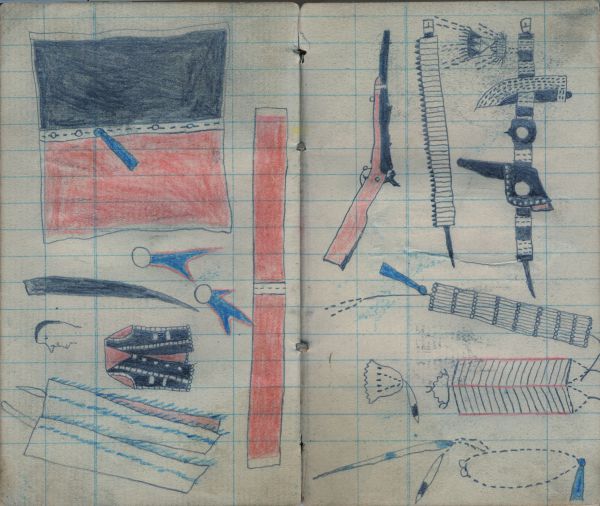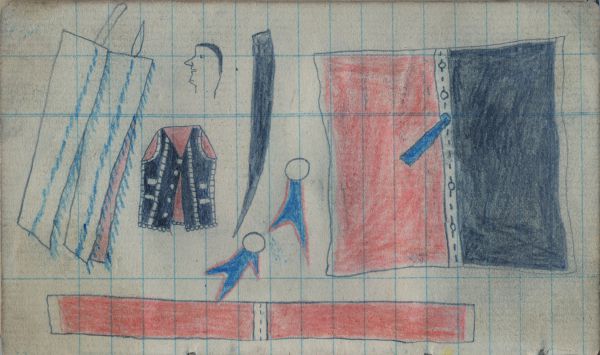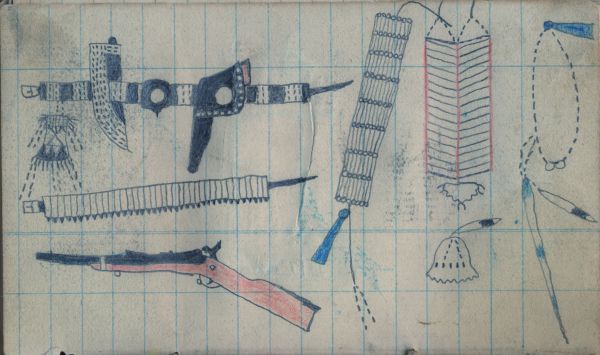2-page drawing: catalog of fine clothing and accoutrements (Cowdrey's 29-30) | 2-page drawing: catalog of fine clothing and accoutrements (Cowdrey's 29-30)
Ethnographic Notes
"My Best Stuff''. In a society with a minimum of personal possessions, clothes absolutely "made the man", at least insofar as this young man was concerned. On Page 30, he has depicted his basic wardrobe; and on Page 29 are shown his "accessories". The long, red rectangle on Page 30 represents his breech cloth made of two lengths of red "saved list" wool blanket cloth, sewn end-to-end. The seam connecting the two pieces is represented by the dotted line at the center. This breech cloth appears in most of the artist's self-portraits. Occasional, alternative breech cloths---like those on Pages 6, 18, 52, 63 & 67---were probably borrowed from a relative.
His courting blanket, made of a red and a dark blue half sewn together, fills the right half of the page. Again, the seam is represented by the medial, dotted line. This is accented with several small, silver conchos or buttons, and a length of blue silk ribbon, into one end of which a sachet of herbal perfume "love medicine" has been wrapped. This blanket appears on Pages 18, 38, 49 & 84. We see the blue silk sachet in profile view, attached to another blanket on Page 67.
The pair of white leather leggings, with the inner flaps painted red, and the fringed sides painted blue, appears on Page 12; and perhaps also on Page 65, if the leather were later painted yellow.
The artist's black wool vest, lined with red muslin or possibly silk, and accented with strips of metallic braid, is shown also on pages 18 & 41 (compare Figure 15). Doubtless it was a basic part of his courting attire, but is obscured in the many compositions where he has wrapped himself in a blanket. A different, borrowed vest is depicted on Page 36. The long, tapering black shape at the center of Page 30 represents a strip of dark-brown fur cut from the tail and spine of an otter skin. Such strips were commonly employed in wrapping a man's braided hair. This one appears twice on Page 25. The circular pair of objects at the center of the page, each with a forked, blue cloth pendant, are problematical. Similar blue shapes appear on Page 25, representing cloth bandanas used to secure the bottom of an otter skin hair wrapper. The circles shown here, however, would not function The pair of white leather leggings, with the inner flaps painted red, and the fringed sides painted blue, appears on Page 12; and perhaps also on Page 65, if the leather were later painted yellow.
The artist's black wool vest, lined with red muslin or possibly silk, and accented with strips of metallic braid, is shown also on pages 18 & 41 (compare Figure 15). Doubtless it was a basic part of his courting attire, but is obscured in the many compositions where he has wrapped himself in a blanket. A different, borrowed vest is depicted on Page 36. The long, tapering black shape at the center of Page 30 represents a strip of dark-brown fur cut from the tail and spine of an otter skin. Such strips were commonly employed in wrapping a man's braided hair. This one appears twice on Page 25. The circular pair of objects at the center of the page, each with a forked, blue cloth pendant, are problematical. Similar blue shapes appear on Page 25, representing cloth bandanas used to secure the bottom of an otter skin hair wrapper. The circles shown here, however, would not function in that context. It is possible that these are intended as an overhead view of nickel-silver or brass armbands, each accented with a folded, blue silk kerchief. These appear nowhere else in the ledger, but the artist's upper arms are generally obscured by an over-wrapped blanket. The artist's "personal jewelry" is shown on the right half of Page 29 (Figure 10). At the center of the page, and very much out of scale, is depicted a choker necklace made of dentalium shells strung between spacers of harness leather decorated with brass upholstery tacks. Compare Little Wolf's choker in Figure 5. Another blue-silk sachet containing herbal perfume is tied to one of the choker laces. This necklace, and especially the sanctified perfume, were high on the artist's list of necessary accoutrements to make himself irresistable to the opposite sex. That may account for its over-large scale in this composition. In nearly every drawing in which the artist's neck is visible, this choker can be seen. Beside the choker is represented a breastplate made of tubular bone beads called "hair pipes", strung between spacers of harness leather. These spacers are either painted red, or have been wrapped with strips of red cotton cloth. From the bottom, center of the breastplate hangs a nickel-silver pectoral ornament, with three crescentic pendants. Often, these pectorals were stamped or rocker-engraved with elaborate designs. Their high cost ·made them prestige items. This breastplate is shown on Page 75. A breastplate of different construction---three panels of hair pipes, rather than two---is shown on Page 18. Next, beside the breastplate, the dotted elipse represents a long necklace of strung brass beads worn diagonally across the torso as a bandolier---compare Figure 15. Tied to the top is another blue-silk sachet. Suspended near the bottom are an eagle feather, and the twisted tail of a longhorn bull. Such ornaments symbolized both the phallus and the scalplock--essential, Cheyenne indications of masculinity. For other examples of these cow tail ornaments and further discussion compare Cowdrey, 1999: 184, 201 and Plates 140 & 156. Below the breastplate is an odd-looking object which represents a short-brimmed felt hat. The dotted lines represent slits cut in the felt, through which colored ribbons might be woven for accent. The artist has done this on Page 63, where this hat identifies him. The erose edge of the hat brim indicates that it has been pinked for additional effect. Compare Little Wolf in Figure 5, for an example of how such a hat was worn; and see Cowdrey, 1999: 121 and Plates 90, 100, 112, 134 & 136, for other Cheyenne drawings showing similar headwear. The left half of Page 29 is devoted to the artist's weapons, and tools of masculine occupation. As discussed earlier, the rifle is an 1884-model Springfield carbine (compare Figures 1, 2 & 3). Above this is depicted a full cartridge belt with brass shells for the carbine. Portrayed at the top of the page is a belt of harness leather decorated with panels of brass upholstery tacks---the white gaps with dotted lines. On this belt are carried four cases. At the right is a holster for an 1860-model Colt Army pistol---compare Figures 1, 4 & 5. The artist's holster has been accented with brass tacks along the edges of the flap, and a round, nickel-silver concho. Next on the belt is a standard-issue, Civil War-era military pouch for carrying primer caps---compare Figures 1 & 4. Like the holster flap, the flap of the primer pouch is decorated with a silver concho. It is this pouch that tells us the mostly-obscured pistol was the 1860-model Colt, which used paper ammunition, and required caps to ignite the gunpowder. Beside the cap pouch is a knife in a boot-leather sheath decorated with brass tacks. Suspended near the belt buckle is a beaded strike-a-light case fringed with tin cone tinklers. Southern Cheyenne men are known to have carried such cases tied to their arrow quivers---compare Figure 6, a drawing which was created about a decade earlier by another young Cheyenne anxious to portray himself in the latest fashion. The composition on Page 29 is the onlv surviving documentation known to this writer which depicts male usage of a strike-a-light pouch at a later period.


